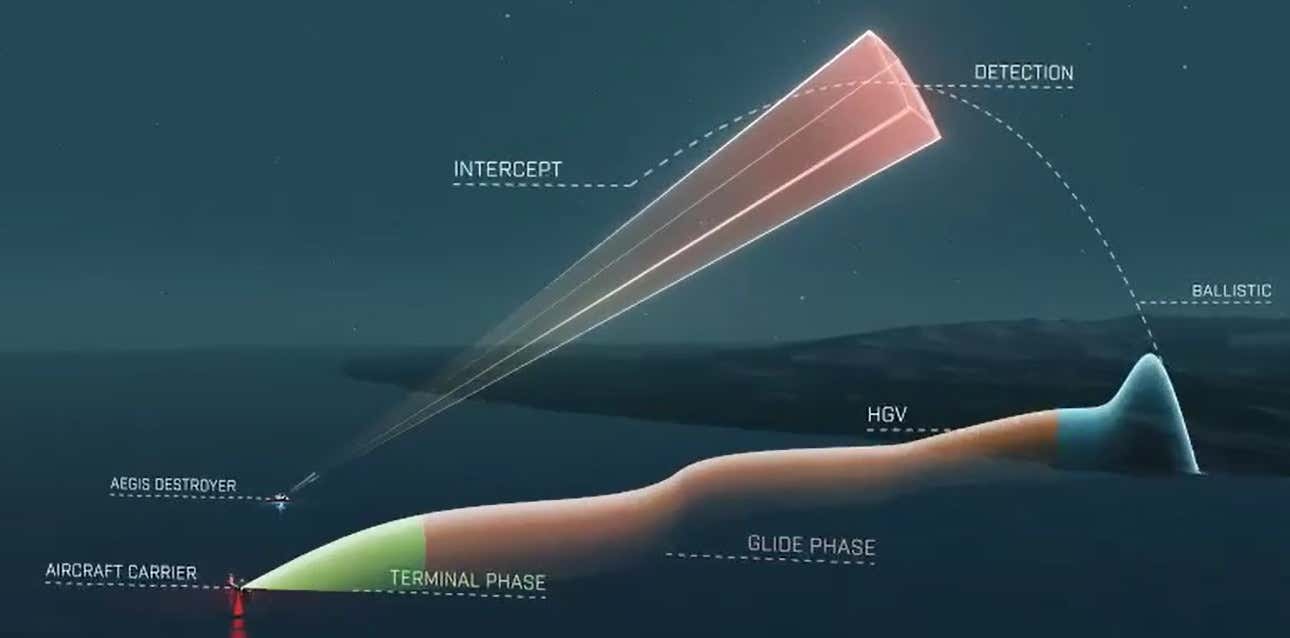As China achieves new milestones in its hypersonic development, the United States is frantically looking to build an impregnable defense system, but there is little success so far.
F-35 Lightning II Set To Get A ‘Lightning Shield’; Key Upgrades To USAF Stealth Jets Will Allow Unrestricted Flight
US Navy Vice Adm. Jon Hill, the head of the US Missile Defense Agency (MDA), recently said that the multi-purpose SM-6 missile is the only weapon in the country’s inventory that can bring down highly maneuverable hypersonic threats.
This follows the agency’s announcement last year that it intends to test an undisclosed version of the SM-6 against an “advanced maneuvering threat,” a word normally associated with unpowered hypersonic boost-glide vehicles, perhaps in the fiscal year 2024.

Hill was speaking about the SM-6 during a discussion regarding hypersonic defensive capabilities at the American Society of Naval Engineers’ Combat Systems Symposium, which began on January 31.
The SM-6 series “is really the nation’s only hypersonic defense capability,” Hill said, without specifying any particular version of this missile. He added that these weapons have a “nascent capability” to engage incoming hypersonic threats.
“We have that and the SM-6 missile with its nascent capability to take on a hypersonic [missile],” he said. [The SM-6] is really the nation’s only hypersonic defense capability.” https://t.co/KGz7XCF1rS
— Alex (@alexgarcialonso) February 2, 2022
“We didn’t call it that back when we got the letter from the CNO [Chief of Naval Operations], the Navy’s top uniformed officer to go develop this program,” he explained. “But the whole idea was to handle high-speed maneuver.”
These comments are significant and are the testimony that the United States acknowledges that intercepting a hypersonic glide vehicle is a very difficult task.
Chinese ‘Stealth’ Espionage! How Beijing-Backed Hackers ‘Acquired’ Sensitive US Tech Used In Its F-35 Fighter Jet?
Unpowered hypersonic boost-glide vehicles typically require a rocket booster to achieve the desired speed and height. The vehicle is then detached from the bulk of the weapon and begins gliding back down along an atmospheric trajectory toward its target at hypersonic speed.
They are designed to be able to make rapid and unanticipated shifts throughout their flight paths, especially when compared to typical ballistic missile trajectories that follow a fixed trajectory.
This mobility, combined with their high speed and general flight profile, makes them extremely difficult to detect and track, particularly with sensors meant for normal ballistic missiles.
Neither MDA nor the US Space Force has stated how far they can monitor hypersonic weapons or how near the US is to intercepting a hypersonic missile. Hypersonic missiles can fly low and maneuver during the cruise phase, evading radar.
They are designed to destroy high-value targets fast, such as aircraft carriers, as previously stated by Air Force Magazine.
Missile-Based Defense
Only the SM-6, one of the 10 primary missiles that arm the Navy’s 285 surface ships and submarines (and counting), is capable of striking targets at sea, in the air, and at the edge of the atmosphere.
New missions are only added to this current missile via software upgrades, as part of Raytheon Technologies’ attempt to quickly deliver new capabilities in the hands of US and allied forces, according to the company.
Teamwork = Success! ? #USSJohnFinn (DDG 113) launches an SM-6 missile during @USPacificFleet #USXIBP21, striking the target. UxS IBP 21 integrates manned & unmanned capabilities into challenging scenarios to generate warfighting advantages.
DETAILS: https://t.co/QLsPNlSo31 pic.twitter.com/MN5GKX9xqC
— U.S. Navy (@USNavy) April 27, 2021
The SM-6 currently has two variants in service, Block I and Block IA, with a third variant, Block IB under development. Block IB missile is significantly different from the previous two variants, with a fully new fuselage and a larger rocket motor. The most spectacular thing about the Block IB variant is that it is expected to be capable of reaching hypersonic speeds and, as a result, to have improved capabilities against hypersonic threats.
However, during an MDA-led test last year, the US Navy fired a pair of SM-6 Dual IIs, a ballistic missile defense-optimized sub-variant of either Block I or Block IA. Those interceptors were unable to destroy a dummy medium-range ballistic missile, the MDA had said in a release.
SM-6 Dual II test record:
FTM-31, Event 2 (2019): Shot down cruise missile target
FTM-31, Event 1 (May 2021): Missed medium range ballistic missile target
FTM-33 (July 2021): Shot down one short range ballistic missile target & unknown status of 2nd SRBM target
FTM-32: TBA https://t.co/Zl4hEjrtAf— Steve Trimble (@TheDEWLine) July 26, 2021
Hill appears to have revealed that the Block I and IA missiles already have some capacity against these more agile hypersonic threats, or were constructed with that capability in mind from the very start. It’s probable that just a few SM-6s now in operation have this capability, which could be the result of post-delivery changes, according to The Drive.
Beyond that, the envelope inside which a current SM-6 may combat hypersonic threats may still be quite small, and the missile may only be useful against particular sorts of targets.
While the SM-6 could be useful to defend against an impending hypersonic glide vehicle attack, the United States has not put all its eggs in one basket. For developing an advanced hypersonic defense system, it remains invested in the ‘Glide Phase Interceptor’ project which is currently under development.
The US military is likewise seeking to fill gaps, particularly by developing a space-based Hypersonic and Ballistic Tracking Space Sensor (HBTSS). Northrop Grumman and L3Harris have been roped in by MDA to build prototype HBTSS satellites, with the objective of beginning on-orbit testing of the two designs in 2023.
American Defense Against HGV
On November 19 last year, the Pentagon revealed that Northrop Grumman, Lockheed Martin, and Raytheon had been chosen to design the Glide Phase Interceptor.
The interceptors would be designed to counter a hypersonic weapon during its glide phase of flight (once a missile has re-entered the earth’s atmosphere and is heading toward its target), which is difficult to predict because hypersonic missiles fly at five times the speed of sound and perform rapid maneuvers, making their trajectory difficult to predict, as previously reported by EurAsian Times.
The interceptors are expected to be manufactured to be integrated into the US Navy’s current Aegis Ballistic Missile Defense destroyers. It would be fired from its conventional Vertical Launch System and linked to the Baseline 9 Aegis Weapon System, which detects, tracks, controls, and engages hypersonic threats, according to the statement.
However, as ambitious and efficient this system sounds, it has essentially hit a funding snag at the moment, according to Defense News.
“The best answer I can give you in this environment today: … We live in a world right now where we don’t have current year appropriations, and we also don’t have insight into the following year’s top line. So, unfortunately, that throttles this program,” Hill said.

“It’s not a technology issue. It is purely a financial problem. And so I can’t say much more other than the fact that we’ve got three great proposals on the table that we’re evaluating now, and that’s going to inform us as we move forward to the next step”, he added.
Apart from the GPI, there is the Hypersonic and Ballistic Tracking Space Sensor (HBTSS). It is just one of several space-based sensor programs being developed by the US military to support missile defense missions.
A Senate panel would move funding control for the Hypersonic and Ballistic Tracking Space Sensor (#HBTSS) back to the Missile Defense Agency from the Space Development Agency (SDA), despite administration reorganization efforts…
Find out more: https://t.co/CiO6GyDnkW pic.twitter.com/7XIOngP3Lf
— Missile Defense Advocacy Alliance (@MissileDefAdv) November 19, 2020
“We’re going to take those first hypersonic tracking space-based sensors in coordination with the U.S. Space Force and we’re going to get them on in orbit,” Vice Adm. Hill said in regards to HBTSS at the Combat Systems Symposium. “That’s through a competitive process and we’re really excited about that. We did so much risk-reduction on the ground we’re absolutely confident that those sensors are going to deliver what we need when we put them up.”
‘Birthday Gift’ To Xi Jinping – Galwan Valley Clash Clearly Pre-Planned; Aimed To Please China’s ‘Top Boss’ – Indian Analyst
Further, the MDA has already indicated how new and old satellites could be utilized to enhance the capabilities of surface-based interceptors against hypersonic threats, whether fired from ships or land-based facilities.
Defense against hypersonic glide vehicles is an important security imperative for the MDA and the US government. Russia and China already possess HGVs and now, North Korea is believed to have joined the club. The fact that all the three countries remain adverse to the US calls for a robust defense.
While given the constraints in both programs, the GPI and the HBTSS could still be years away. That explains the endorsement of the SM-6. The latest variant could prove to be the best bet for the MDA.
- Contact the author at sakshi.tiwari9555@gmail.com
- Follow EurAsian Times on Google News




